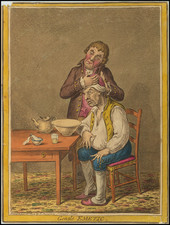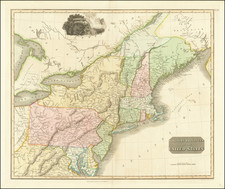Early engraving showing John Malcolm being removed from his home by a band of Patriots, shortly before he was tarred and feathered in January 1774.
The image shows John Malcolm being forcibly bound and lowered onto a cart from the window of his own house after a mob had broken in and subdued him.
The tarring and feathering of John Malcolm was one of the most publicized incidents of its kind in the Revolution period. He was a Bostonian who worked for the British customs service, and known as a hard-line Loyalist and staunch supporter of royal authority. On January 25, 1774, according to the account in the Massachusetts Gazette, George Robert Twelves Hewes, a Patriot who a month earlier had protested at the Tea Act by dumping tea into Boston Harbour (the 'Boston Tea Party') saw Malcolm threatening to strike a boy with his cane. When Hewes intervened to stop Malcolm, the two began insulting each other, after which Malcolm struck Hewes hard on the forehead with the cane.
Hewes went to a magistrate's office to get a warrant for his assailant's arrest. That night a mob seized Malcolm in his house and dragged him into King Street where, over the objections of Hewes, he was covered with tar and feathers. They then took him to the Liberty Tree, where they first threatened to hang him and then threatened cut off his ears if he did not apologize for his behavior and renounce his customs commission. Malcolm relented and was sent home. The event was reported in newspapers on both sides of the Atlantic.
An early impression of this remarkable image, before the addition of the publication line.
John Malcolm (died 1788) was a sea captain, army officer, and British customs official who was the victim of the most publicized tarring and feathering incident during the American Revolution. John Malcolm was a strong supporter of royal authority. During the Regulation Movement, he traveled to North Carolina to help put down the uprising. While working as a customs agent to the King, he was drew the wrath of the local populace. In November 1773, sailors in Portsmouth, New Hampshire, tarred and feathered him. Malcolm got off relatively easy in this attack, since the tar and feathers were applied while he was still fully clothed..









![[Historical Time Line Map -- Creation To 100 AD] Tableau de L'Histoire Sainte Depuis La Creation du monde jusqu'a la dispersion du Juifs . . .](https://storage.googleapis.com/raremaps/img/small/82069.jpg)

![(South Sea Bubble) De Windverkopers of Windvangers, die door wind, verliezen Geld en Goed; bederven Vrouw en Kind [The wind sellers or wind catchers, who through wind, lose money and goods; ruin wife and child.]](https://storage.googleapis.com/raremaps/img/small/95952.jpg)

![(Coast of Florida, Georgia and the Carolinas] [To The Members Of The Nautical Institution And Ship-Masters' Society Of The City Of New York, This Chart, Extending From Lat. 40°15 N., Long. 72°15 W., to Lat. 22°35 N., Long. 80°25 W., Is Respectfully Dedicated / By Their Obedient Servant Edmund M. Blunt]](https://storage.googleapis.com/raremaps/img/small/77294.jpg)
![[ Early United States Map ] Carte Des Etats-Unis De L'Amerique Septentrionale, dresse d'apres des Cartes Anglaises…](https://storage.googleapis.com/raremaps/img/small/39783.jpg)